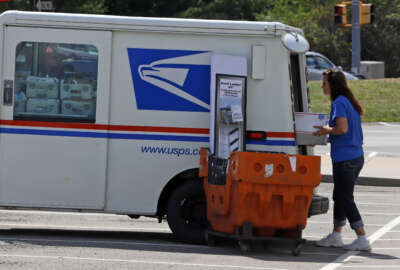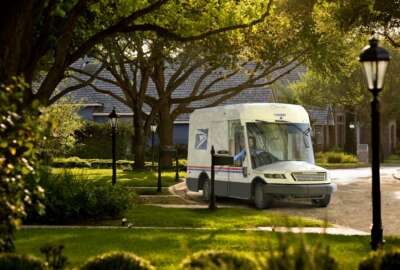Hubbard Radio Washington DC, LLC. All rights reserved. This website is not intended for users located within the European Economic Area.
USPS ‘heading in the right direction’ with electric vehicles, but advocates press for more
The Postal Service is laying the foundation for electric vehicles to make up a majority of its fleet in less than a decade, a plan that puts the agency well ah...
The Postal Service is laying the foundation for electric vehicles to make up a majority of its fleet in less than a decade, a plan that puts the agency well ahead of the Biden administration’s green government goals.
But advocates and environmental groups — some of which have sued USPS over its future fleet plans — are calling on the agency to commit to a 100% electric fleet, or make nearly all of its new vehicles electric.
USPS says its preferred plan is to purchase more than 106,000 new vehicles over the next six-to-eight years, to replace aging vehicles still on the road — and that 62% of those vehicles will be electric.
Those vehicles are a combination of custom-built Next-Generation Delivery Vehicles manufactured by Oshkosh Defense and commercial off-the-shelf vehicles.
USPS announced last December that 75% of its Next-Generation Delivery Vehicles will be electric, thanks to $3 billion in funds from the Inflation Reduction Act.
Patrick Ecker, USPS’s executive manager for fleet strategy and support, said in a recent public briefing that USPS, as part of that proposed plan, expects to reduce cumulative greenhouse gas emissions by about 3.9 million metric tons by 2030, and “decrease substantially” its fuel costs.
Ecker expects USPS electric vehicles would be able to travel at least 70 miles on a single charge — its minimum operational requirement, to ensure that letter carriers can complete their routes without the risk of running out of power.
But USPS is also looking to purchase commercially available vehicles to replace 30-year-old delivery trucks that are nearing the end of their life.
Postmaster General Louis DeJoy said last December that USPS will “continue to explore the financial and operational feasibility of achieving 100% electrification for the overall Postal Service delivery fleet.”
“As I have said from the beginning of this journey, the Postal Service needed to replace a 30-year-old fleet of unsafe vehicles, which was specifically designed to do our unique work,” DeJoy said.
USPS spokesman David Partenheimer said USPS “remains committed to the electrification of our delivery vehicles in a responsible manner, consistent with our operating strategy, the deployment of appropriate infrastructure, and our financial condition, as we continue to modernize America’s largest and oldest federal fleet.”
USPS expects all of its new vehicles — both gasoline and electric — will be more sustainable than its current aging fleet.
Ecker said the proposed gasoline-powered vehicles would get 25-44% better gas mileage than the Grumman Long-Life Vehicles (LLVs) they are replacing.
LLVs currently account for a majority of the USPS fleet. Ecker said these vehicles are “past or nearing the end of their useful life.”
Those LLVs, on average, are 30 years old, and well beyond their expected lifespan of 24 years. Ecker said they are also becoming increasingly costly to maintain.
LLVs also lack modern safety features, including airbags, air conditioning, anti-lock brakes, backup cameras, daytime-running lights and windshield wipers.
“It is vital that the Postal Service modernize our delivery fleet to provide our 200,000 mail carriers with appropriate vehicles that allow them to support our daily service mission with advanced safety and security features, better fuel economy and the amenities that we expect in our own personal vehicles,” Ecker said.
Next-generation delivery vehicles will also have expanded cargo holds that allow for greater capacity for packages.
USPS held a public hearing on July 26 under the National Environmental Policy Act (NEPA), a federal procedural law that requires federal agencies to consider the environmental impacts of their major acquisitions.
USPS issued a Supplemental Environmental Impact Statement (SEIS) in June to reflect several recent changes to its fleet acquisition plans.
The agency is looking to make smaller, more frequent purchases over shorter periods of time, then lock in bulk orders over the next decade.
“Smaller, more frequent purchases of vehicles provide us an opportunity to increase the electric vehicle proportion over time as the market develops,” Ecker said.
USPS is also ordering significantly more electric vehicles than it previously expected, considering the $3 billion received in the Inflation Reduction Act. Those funds are limited to USPS buying more electric vehicles and charging stations.
Prior to the spending bill passing, USPS expected electric vehicles would make up, at minimum, 10% of its next-generation delivery vehicle fleet.
The SEIS also reflects USPS’s plans to buy tens of thousands of commercial off-the-shelf (COTS) vehicles to address the replacement of its aging fleet.
Ecker said USPS expects to be able to purchase COTS vehicles faster than custom-build NGDVs in 2023 and 2024
“Although the availability of electric vehicles has expanded, the existing market is still limited for the Postal Service’s needs for replacement vehicles over the next few years,” he said.
Many individuals during the public comment period commended USPS for committing more fully to electric vehicles, but are pressing the agency to fully electrify its fleet, or come close to it.
“We’re glad to see you moving in the right direction, but also say this still falls very short of where we need to be on electric vehicle commitment,” said Annie Norman, a top official with the Save the Post Office Coalition.
Candice Youngblood, attorney at the nonprofit environmental law firm Earthjustice, said USPS’s latest proposal is a “long way” from its initial plan of only making electric vehicles 10% of its custom-built fleet.
Youngblood said USPS’s last electric vehicle plans mark a “critical step toward the federal government meeting the Biden administration’s climate goals,” but urged the agency to lock in its commitment to only purchase electric NGDVs after 2026.
Ecker said that “not all Postal Service delivery vehicle routes are compatible with electric vehicles, since USPS expects those vehicles won’t be able to complete those routes on a single charge.
He added that some routes with significant snowfall, cold weather or “challenging terrain” would be better suited for all-wheel drive vehicles that are more likely to be gas-powered.
A USPS inspector general report in March 2022, however, found that only about 2,600 routes — about 1.5% of its total routes nationwide — would not be suited for electric vehicles.
Britt Carmon, senior advocate for the Natural Resources Defense Council, said the nonprofit appreciates USPS significantly increasing the percentage of the fleet that will be electric vehicles, but said the plan still “falls short of what’s possible,” and that USPS should set more ambitious targets to reduce greenhouse gas emissions.
“Failure to do so will lock in decades of fossil fuel vehicles operating in these communities,” Carmon said.
Carmon added that USPS could justify buying more electric vehicles if it looked at the total cost of ownership, rather than the initial upfront cost.
USPS began its delivery fleet modernization processing in 2015, when it initiated the design and prototype work for a new purpose-built vehicle for postal service delivery operations. The agency awarded its NGDV contract to Oshkosh Defense in February 2021.
The agency announced in March 2022 that it spent nearly $3 billion on 50,000 next-generation vehicles as part of its initial order to the vendor Oshkosh Defense. More than 10,000 vehicles as part of that initial order are electric vehicles.
Copyright © 2024 Federal News Network. All rights reserved. This website is not intended for users located within the European Economic Area.
Jory Heckman
Jory Heckman is a reporter at Federal News Network covering U.S. Postal Service, IRS, big data and technology issues.
Follow @jheckmanWFED





